
Neutron-Neutron, Proton-Proton, verses Proton-Neutron (Deuteron) Enigma Explained
Subtle but positive proof that the electric charge of the quarks controls the structural relationship between protons and neutrons.
One of the long-standing quandary of nuclear physics is why does the p-n pair(proton-neutron or deuterium) form a stable nucleus but the p-p pair(proton-proton) does not form a stable nucleus. Even more puzzling is why the n-n (neutron-neutron)pair will not form a stable particle?
Analyzed from the perspective of the current nuclear models and using the existing concept that the electric charge of a proton is a simple +1 and the electrical charge for the neutron is assumed to be simply 0, thus the strong force should bind a n-n pair together and form a stable particle. So why doesn't n-n pairing occur?
The p-p pairing
is easy to comprehend and explain why a proton, proton coupling is unlikely to occur. The two positive charges pressure the protons to repel each other forcing them apart. Evidently for the pp pairing the strong force is not strong enough to keep and hold two positively charged protons together.
The p-n pairing
does exist as deuterium and is explained because the neutron being neutral electrically does not repel and is not repelled by the proton so the strong force holds the two dissimilar nucleons together.
The n-n pairing
there is no logical reason that these two nucleons cannot pair up. Neither nucleon is charged so they do not repel each other electrically. Thus, the strong force should easily bring and hold the two neutral neutrons together. However, two neutrons do not form a particle.
The following poster illustrates the current standard model thinking and the unknowns that the standard model represents.
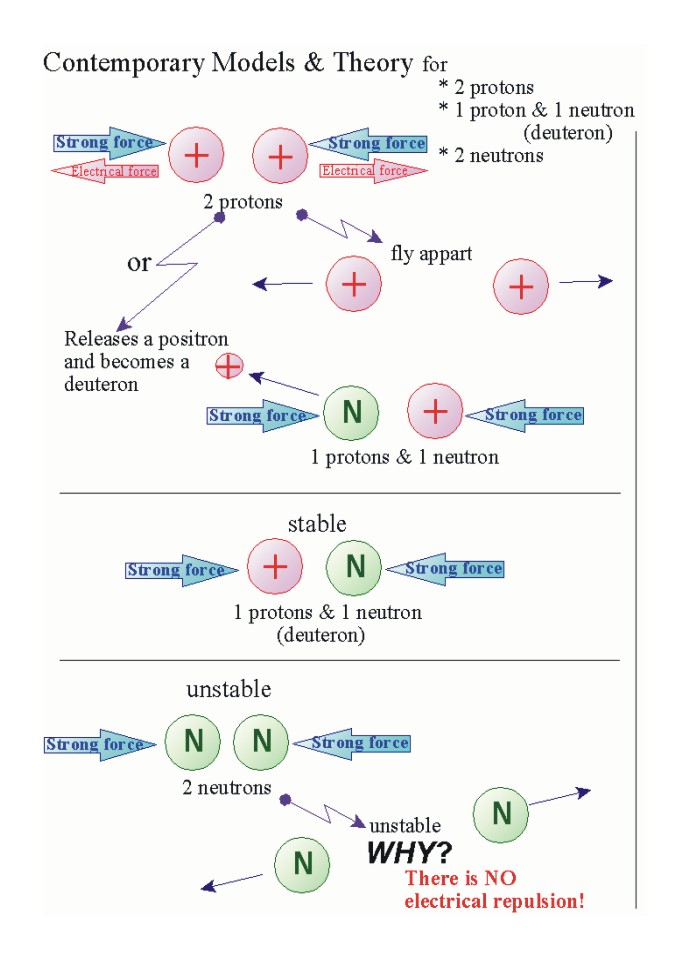
Following this poster is the solution to the n-n enigma
This quark based model fully explains this seeming paradox and that solution is completely logically.
SOLUTION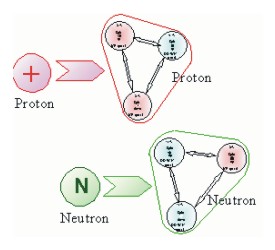
The solution to the problem is solved when it is realized that protons and neutron are not single particles but compound particles. Each is composed of three electrically charged quarks, the proton has two up quarks with a charge of +2/3 each and one down quark with a charge of -1/3, and the neutron is composed of two down quarks and one up quark. When we examine the same three pairings of protons and neutrons using the quark lattice model, the result observed in nature are obvious. The electrical charge of the quarks indicates that two protons still repel each other electrically, additionally the electrical charge of the quarks results in two neutrons also repelling each other electrically. Interestingly a proton and neutron actually attract each other electrically in one configuration and repel in the two other configurations. The p-p match ups are shown below first, the n-n match ups are shown second and the p-n are shown last. Each pairing is shown using some illustrations. The final deuteron is shown both as an illustration and a �ZOME� construct. |
|
Proton-Proton |
||
|
1. The first match up places the up quarks opposed to each other and the down quarks also opposed. This alignment results in maximum repulsions and thus no particle is formed No Electrical Attraction - Maximum Electrical Repulsion |
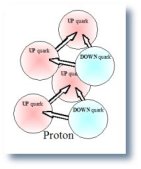 |
|
|
2 & 3. Now rotate the upper proton by one quark to the left or right and two pairs of quarks align but two up quarks are still situated next to each other. The two up quarks repel resulting in electrical instability for the particle. Thus, two protons are unstable electrically at both the macro and micro levels. Electrical Attraction and Repulsion - Unstable |
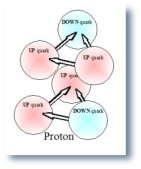 |
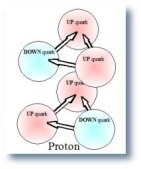 |
|
Neutron-Neutron |
||
|
4. The first match up places the down quarks opposed to each other and the up quarks are also opposed. This alignment results in maximum electrical repulsion, and thus no stable particle can form. No Electrical Attraction - Maximum Electrical Repulsion |
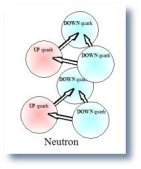 |
|
|
5 & 6. Now rotate the upper neutron by one quark to the left or right and two pairs of quarks align but two down quarks are still situated next to each other. The two down quarks repel resulting in electrical instability for the particle. Thus, two neutrons are unstable electrically at both the macro and micro levels. Electrical Attraction and Repulsion - Unstable |
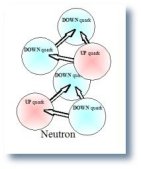 |
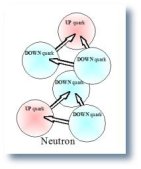 |
|
Proton-Neutron |
||
|
7. The first match up positions the two down quarks in the neutron directly over the two up quarks in the proton. Also the up quark in the neutron is positioned directly over the down quark in the proton. This alignment results in maximum electrical coupling which forms a stable particle. Thus, a proton and neutron form a deuteron by stacking their three quarks in an electrical alignment when placing one on top of the other in a stable electrical and magnetic mode. No Electrical Repulsion - Maximum Electrical Attraction |
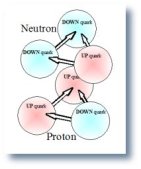 |
|
|
8 & 9. Now rotate the upper neutron by one quark to the left or right and two pairs of quarks align but two down quarks and two up quarks are now situated adjacent to each other. The two down and two up quarks repel, resulting in electrical instability for the particle. Electrical Attraction and Repulsion - Unstable |
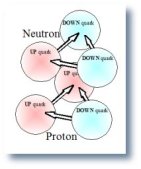 |
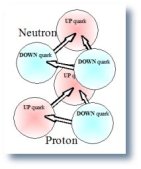 |
|
So, for the nine possible alignments of the three quarks
contained in systems of protons and/or neutrons that pair, there is
only one alignment that results in a stable particle, the deuteron! 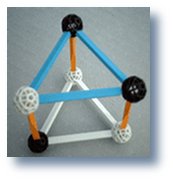 |
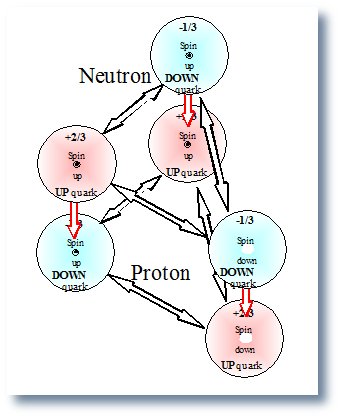 |
|